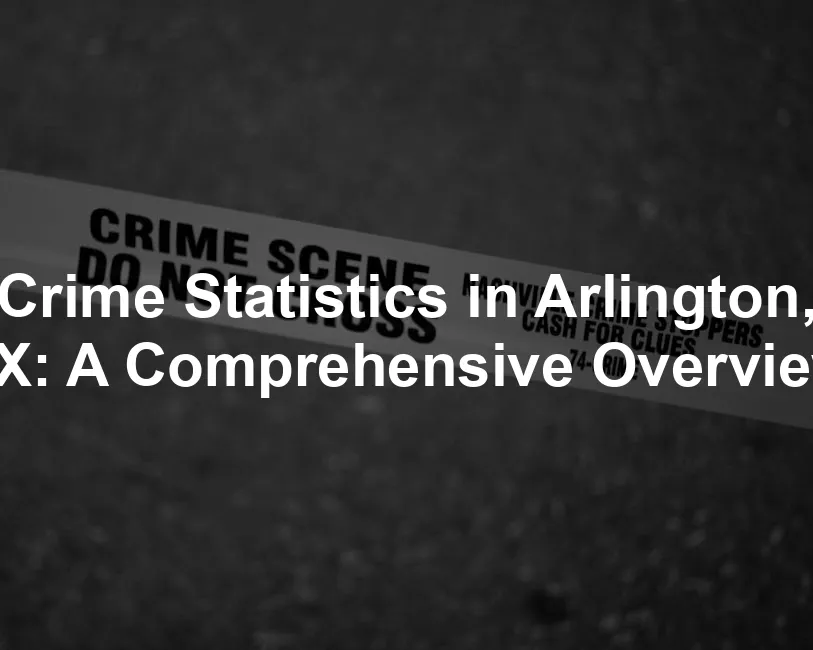Introduction
Understanding crime statistics in Arlington, Texas, is crucial for current residents and those considering a move. With a population exceeding 400,000, Arlington is a vibrant city known for its attractions, such as the Texas Rangers and Six Flags Over Texas. However, crime rates can impact community perceptions and overall quality of life.
In this article, we aim to shed light on the crime landscape in Arlington. We’ll discuss various aspects of crime statistics, including recent crime rates, types of crimes prevalent in the area, historical trends, neighborhood safety, and what residents think about safety within the city.
Why does this matter? Well, whether you’re a longtime resident or new to the area, knowing the crime statistics helps you make informed decisions. It assists in evaluating neighborhood safety and understanding local law enforcement efforts. So, grab your detective hat as we uncover the mysteries of Arlington’s crime statistics!
Understanding Crime Statistics
What are Crime Statistics?
Crime statistics are numerical representations of crime occurrences within a specific area over a defined period. These figures play a vital role in understanding public safety and the effectiveness of law enforcement. They help citizens, policymakers, and researchers analyze trends, allocate resources, and develop strategies to combat crime.
Collecting crime data is no small task. The FBI’s Uniform Crime Reporting (UCR) program serves as a primary source for this information. The UCR compiles reports from over 18,000 law enforcement agencies across the United States. It categorizes crimes into two main groups: violent and property crimes. Violent crimes include offenses like murder, rape, robbery, and assault, while property crimes encompass burglary, theft, and motor vehicle theft.
The UCR program ensures standardized reporting, allowing for accurate comparisons across different locations and timeframes. This methodology helps paint a clearer picture of crime trends and their implications for community safety.

Overview of Arlington, TX
Arlington boasts a diverse demographic profile, with a population of approximately 400,000 residents. The city showcases a rich cultural tapestry, with various ethnicities contributing to its vibrant community. Notably, Arlington’s economy thrives, offering a mix of employment opportunities across sectors like retail, education, and healthcare.
However, with this growth comes challenges, including crime. Recent statistics reveal that Arlington has a total crime rate of 31.22 per 1,000 residents, which exceeds national averages. Understanding these statistics within the context of Arlington’s socio-economic landscape is crucial. By examining the interplay between demographics and crime, we can better understand the factors influencing safety in the city.
As we continue, expect a thorough exploration of current crime rates, types of crimes, and neighborhood safety. We’ll also tackle local perceptions of safety, helping you navigate Arlington’s crime statistics with confidence!
Crime Rates in Arlington, TX
Current Crime Rate Overview
Arlington, Texas, has a total crime rate of 31.22 per 1,000 residents. That’s a bit higher than the national average, which hovers around 23 per 1,000. If you’re wondering what that means for you, it means your chances of becoming a victim of crime are about 1 in 32. Now, that sounds a bit alarming, but let’s put it in perspective. Most cities in Texas report lower crime rates than Arlington. For example, cities like Pantego and Dalworthington Gardens boast significantly lower numbers.
So, how does Arlington compare on a broader scale? Well, it ranks quite high among cities of similar size. With a population exceeding 400,000, Arlington is bustling, and as they say, with great size comes great responsibility—or in this case, crime! It’s essential to keep it real; while crime exists, many neighborhoods are safe and welcoming.

To stay safe, consider investing in a Home Security System. It provides peace of mind, allowing you to monitor your property and deter potential intruders. Because let’s face it, no one wants to play hide and seek with a burglar!
Violent Crime Statistics
Now, let’s break down the violent crime statistics in Arlington. The violent crime rate stands at 5.78 per 1,000 residents. This includes grave offenses such as murder, rape, robbery, and assault. Below is a table that summarizes these violent crimes:
| Crime Type | Number of Crimes | Rate per 1,000 Residents |
|---|---|---|
| Murder | 16 | 0.04 |
| Rape | 344 | 0.87 |
| Robbery | 276 | 0.70 |
| Assault | 1,646 | 4.17 |
As you can see, assault accounts for the largest portion of violent crimes. It’s worth noting that while the numbers may seem high, they contribute to a broader trend. Over the past few years, Arlington has seen fluctuations in these rates. For example, the murder rate has remained relatively stable, but assaults have shown a slight uptick.

Property Crime Statistics
When it comes to property crimes, Arlington also exhibits significant figures, with a property crime rate of 25.44 per 1,000 residents. This rate includes various offenses such as burglary, theft, and motor vehicle theft. Here’s a snapshot of property crime trends:
| Crime Type | Number of Crimes | Rate per 1,000 Residents |
|---|---|---|
| Burglary | 1,032 | 2.62 |
| Theft | 7,767 | 19.68 |
| Motor Vehicle Theft | 1,239 | 3.14 |
Theft takes the lead, with a whopping 19.68 per 1,000 residents. This makes sense, considering Arlington’s vibrant retail scene. But, it also highlights the importance of vigilance. Consider adding some Security Camera System to your home. These devices can deter thieves and help you keep an eye on your property, because let’s be real—nobody wants to play the role of a detective after the fact!
Visual representations of these trends illustrate peaks and valleys. For instance, while property crime has seen a decrease in some areas, motor vehicle theft remains a concern, with Arlington having one of the highest rates in the nation.
In summary, Arlington’s crime rates present a mixed bag. While it may be more significant than some surrounding areas, understanding the specifics can help residents and potential movers make informed decisions. Stay alert, but don’t let the numbers deter you from enjoying all that Arlington has to offer!
Historical Crime Trends
Year-over-Year Changes
Arlington, Texas, has experienced notable shifts in crime rates over the years. Recent data indicates a slight decrease in total crime by about 3.2% from 2021 to 2022. Violent crime saw a modest uptick of 0.1%, while property crime decreased by 3.9%. This oscillation in crime trends illustrates the complexities surrounding public safety in urban areas.
Let’s break down some of the main categories. The violent crime rate stands at 5.78 per 1,000 residents, which, while alarming, is consistent with broader trends seen across the state. Murder rates remain relatively stable, with 16 recorded in 2022, while assaults account for the bulk of violent offenses.
On the property crime front, the rate is at 25.44 per 1,000 residents. The most significant contributor to this figure is theft, which is particularly prevalent given Arlington’s bustling retail landscape. Motor vehicle theft remains a critical concern, with Arlington noted for having one of the highest rates in the nation.
(Insert graph or chart here visualizing these trends)

Long-term Historical Analysis
Taking a longer view, we can see how crime rates in Arlington have fluctuated over the past decade. Between 2012 and 2022, the violent crime rate has shown a somewhat volatile pattern. For instance, in 2013, the rate peaked at 485 per 100,000 residents but has since declined to around 339.1 in 2022. While it’s encouraging to see this reduction, it’s essential to acknowledge that violent crime remains higher than national averages.
Property crime follows a similar story. In 2012, the property crime rate was significantly higher, around 364.3 per 100,000 residents. Over the years, it has seen a gradual decline, landing at 197.0 in 2022. This reduction aligns with various community initiatives aimed at enhancing neighborhood safety.
Several social and economic factors contribute to these trends. Economic growth often leads to increased population density, which can correlate with higher crime rates. Additionally, rising living costs and income inequality may push some individuals toward criminal activity. These economic pressures have been evident in Arlington, given its diverse demographic and rapid development.
Overall, while Arlington faces challenges regarding crime, the city is actively working to improve safety and reduce crime rates through community outreach, law enforcement initiatives, and public awareness campaigns.
Neighborhood Safety in Arlington
Crime by Neighborhood
Arlington is a patchwork of neighborhoods, each with its own unique crime profile. Some areas, like Pantego and Dalworthington Gardens, boast significantly lower crime rates compared to the city average, making them popular choices for families and individuals seeking a safer environment. In contrast, neighborhoods like Central and North Arlington have higher crime rates, particularly in violent and property crimes.
Analyzing specific neighborhoods reveals distinct patterns. For instance, areas with a higher concentration of businesses and nightlife often report increased theft and vehicle-related crimes due to the density of traffic and footfall. Meanwhile, more residential areas tend to have lower crime statistics, particularly for violent crimes.

Community Safety Perceptions
Survey results indicate a mixed sentiment among Arlington residents regarding safety. Approximately 36% of residents report feeling safe walking alone at night, while 64% express concerns about overall safety in their community. This discrepancy highlights the complex nature of crime perception, where some neighborhoods feel secure while others do not.
Statistics reveal that while property crimes may dominate the statistics, many residents still enjoy their community and engage in outdoor activities. Understanding these perceptions is crucial for city planners and law enforcement, as it helps identify areas needing more attention or community outreach.
Law Enforcement and Community Initiatives
The Arlington Police Department is proactive in its efforts to combat crime. With a variety of initiatives, including community policing and neighborhood watch programs, the department fosters collaboration between law enforcement and residents.
Community involvement plays a vital role in enhancing safety. Programs aimed at increasing awareness and encouraging citizen participation have proven effective. Residents can attend meetings, participate in safety workshops, and engage with officers directly, creating a stronger bond between the community and law enforcement.
In summary, while Arlington faces challenges regarding crime, the city’s initiatives and community involvement are crucial in addressing these issues. With ongoing efforts, Arlington aims to cultivate a safer environment for all its residents.
Factors Influencing Crime in Arlington
Economic and Social Factors
Crime rates in Arlington, Texas, are influenced by various economic and social factors. One significant factor is income inequality. In communities where the wealth gap is wide, crime rates often rise. People struggling to make ends meet might resort to illegal activities. This leads to a cycle where crime breeds more crime, creating challenges for law enforcement.
Unemployment rates also play a crucial role. When people lack jobs, they may feel desperate and turn to crime as a means of survival. Arlington has seen fluctuations in job availability, which correlates with crime trends. Areas with high unemployment often report higher crime rates, especially property crimes.
Housing costs are another contributing factor. Arlington has experienced a surge in housing prices, making it tough for many residents to find affordable places to live. High housing costs can lead to increased stress and instability, driving some individuals to commit crimes. When people struggle to pay rent, the temptation to engage in illegal activities may rise.
The cost of living in Arlington is lower than the national average, but it still poses challenges. While expenses like housing are generally affordable, the prices have increased compared to nearby cities. This can create pressure on families, contributing to crime. For instance, residents in Arlington face average rent costs around $1,089, which can strain budgets, especially if incomes don’t match rising costs.

In summary, economic challenges, including income inequality, unemployment, and rising housing costs, play a pivotal role in shaping crime rates in Arlington. Understanding these elements can provide residents and potential movers with insights into the city’s safety landscape.
Demographic Factors
Demographic changes significantly influence crime statistics in Arlington. Over the years, the city has experienced population growth and urbanization. With a population exceeding 400,000, Arlington has become more diverse. Different demographics can lead to various social dynamics, impacting crime rates.
For instance, urbanization often brings a mix of cultures, lifestyles, and economic situations. New residents may have varying access to resources, education, and job opportunities. Such disparities can create tensions, potentially leading to increased crime, especially in densely populated areas.
Moreover, a growing population can strain local resources, including public services and law enforcement. More residents mean more potential for conflict and, unfortunately, crime. The city has seen fluctuations in crime rates as it adapts to these demographic shifts.
Historically, Arlington’s crime rates have varied in response to these changes. For example, as the city has urbanized, certain neighborhoods have experienced spikes in property crimes, reflecting the challenges that come with increased density and diversity.

In summary, demographic changes in Arlington, including population growth and urbanization, significantly impact crime statistics. Understanding these factors is essential for residents and those considering a move to the area, as they reveal the complexities of community safety and crime dynamics.
Conclusion
In conclusion, understanding crime statistics in Arlington, Texas, is essential for residents and potential movers. The factors influencing crime rates are multifaceted, including economic pressures and demographic changes. By examining issues like income inequality, unemployment, and housing costs, we can grasp why crime exists within the city.
It’s equally important to note the historical context. Arlington has seen fluctuations in crime as it adapts to growth and urbanization. Awareness of these trends can help residents feel more secure in their neighborhoods. Additionally, engaging with local law enforcement and community initiatives can foster a safer environment.
For those contemplating a move to Arlington, being informed about crime statistics can aid in decision-making. Not all neighborhoods have the same safety profiles, so knowing which areas are safer can enhance your living experience.

As a community, staying informed and involved in local safety initiatives is crucial. Whether attending community meetings or participating in neighborhood watch programs, residents can contribute to making Arlington a safer place.
In summary, understanding crime statistics and their underlying factors empowers residents. It encourages active participation in community safety, fostering a sense of security and connection. So, let’s stay informed and work together to keep Arlington safe!
FAQs
What is the overall crime rate in Arlington, TX?
The overall crime rate in Arlington, TX, is 31.22 per 1,000 residents. This statistic places Arlington above the national average, which is around 23 per 1,000. If you’re curious about your chances, they stand at about 1 in 32 for becoming a victim of either a violent or property crime. While those odds may sound concerning, keep in mind that many neighborhoods in Arlington are considered safe and welcoming.
How safe is Arlington compared to other cities in Texas?
When compared to nearby cities, Arlington’s crime rates reveal a mixed bag. For instance, cities like Pantego and Dalworthington Gardens report notably lower crime rates. In contrast, Arlington’s crime rate is 34% higher than the national average. However, for cities of similar size, Arlington’s figures aren’t the worst. Overall, Arlington has a slightly higher crime rate than the average Texas city, making it essential to choose your neighborhood wisely.
What should I know about crime in specific neighborhoods?
Crime rates fluctuate across different neighborhoods in Arlington. Areas like Pantego and Southwest Arlington are generally safer, making them appealing for families and individuals seeking peace of mind. However, neighborhoods like Central and North Arlington have higher crime rates, particularly in violent and property crimes. When considering a move, it’s wise to research specific neighborhoods to find the right fit for your safety needs.
How can residents contribute to reducing crime in Arlington?
Residents play a crucial role in enhancing community safety. Here are a few actionable steps you can take: 1. Join or create a neighborhood watch: Collaborating with neighbors can deter criminal activity. 2. Report suspicious activities: Always report any unusual behavior to the police. 3. Get involved in community meetings: Attend local safety meetings to stay informed and engaged. 4. Enhance home security: Simple measures, like installing security cameras or better lighting, can make a big difference. By working together, residents can create a safer Arlington for everyone.
Where can I find more information about specific crimes in my area?
For those looking to dig deeper into crime data, several resources are available: – Arlington Police Department: Their website offers a neighborhood crime search tool for detailed information. – NeighborhoodScout: Provides crime reports and analytics for specific areas. – Local news outlets: Often report on crime trends and community safety initiatives. – Community forums: Engage with other residents to share experiences and gather insights. Utilizing these resources ensures you stay informed about crime in your area and can make educated decisions regarding safety.
For a deeper understanding of crime statistics in Arlington, you can refer to this comprehensive analysis on Arlington TX Crime Statistics.
Please let us know what you think about our content by leaving a comment down below!
Thank you for reading till here 🙂
And to keep your home safe, consider having a Personal Safety Alarm on hand. It’s a simple tool that can make a big difference in emergencies, providing you with an extra layer of protection!
Also, if you’re into fitness, a Fitness Tracker can be a great addition to your daily routine. Keep track of your steps, heart rate, and more while you work on keeping yourself safe and healthy!
All images from Pexels




